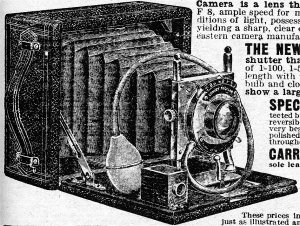
Format: 4x5, 5x7
Medium: dry plate
Lens type: sliding focus
Shutter: Conley Safety
Aperture: f.8 - f.128
Speeds: T, B, 1/100, 1/50, 1/25, 1/5, 1/2, 1"
Nickel-plated lensboard frame featuring rise and fall movements; non-reversable back.
Same camera as the Model VIII except for the shutter.
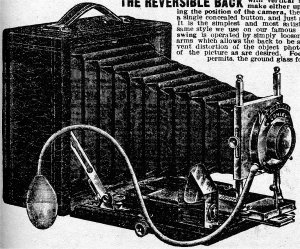
Format: 4x5, 5x7
Medium: dry plate
Lens type: sliding focus
Shutter: Conley Safety
Aperture: f.8 - f.128
Speeds: T, B, 1/100, 1/50, 1/25, 1/5, 1/2, 1"
Nickel-plated lensboard frame featuring rise and fall movements; rear tilt; rack and pinion focus; non-roatating reversable back. Hidden release button on side detaches the back.
Same camera as the Model IX.
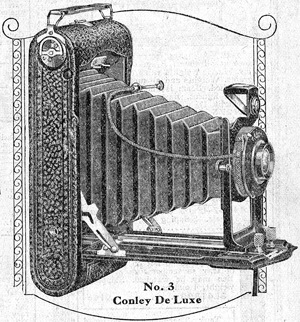
Format: 2 1/4 x 4 1/4 (No 2a), 3 1/4 x 4 1/4 (No 3), 3 1/4 x 1/2 (No 3a)
Medium: roll film (116, 122, 125)
Lens type: sliding focus
Shutter: Victo or Acme
Speeds: 1/100, 1/50, 1/25, 1/10 (Victo); 1/300, 1/200, 1/100, 1/50, 1/25, 1/5, 1/2, 1" (Acme)
A somewhat higher-end version of the Junior. The 2a featured an extended bellows for portraits. All models had an open-frame front standard with rise and fall movements, and a choice of two shutters, options normally found on more expensive plate cameras. Early versions were called the Model B, Model C, and Model E.
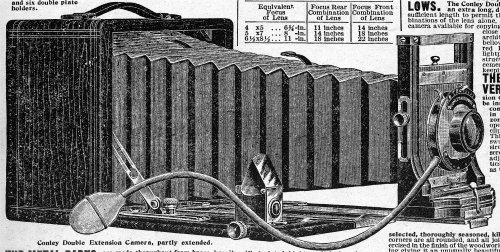
Format: 4x5, 5x7, 6 1/2 x 8 1/2
Medium: dry plate
Lens type: sliding focus
Shutter: Conley Automatic
Aperture: f.8 - f.128 (when using convertible lenses, up to f.256)
Speeds: O, T, B, 1/100, 1/50, 1/25, 1/5, 1/2, 1"
Non-rotating reversable back with hidden release button. Wooden lensboard mount. Vertical rise and fall, horizontal shift, rear tilt. Rack and pinion focus. Were often equipped with triple-convertable lenses which could be used singly or in combination to achieve focal lengths of 6 1/2", 10", or 14". See Shutters for more about convertible lenses.
When not at full extension, can be easily distinguished from the Long Focus / Model XV by the presence of two leather eyelets on top of the bellows. Long Focus has only one.
Same camera as the Model XVIa except for the reversable back.
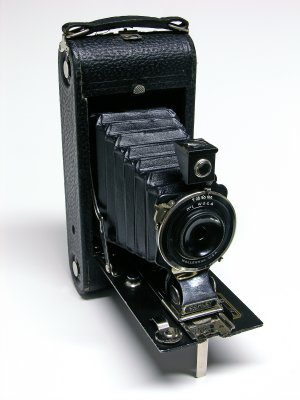
Format: 2 1/4 x 3 1/4 (No 2); 2 1/4 x 4 1/4 (No 2a)
Medium: Roll-film (120, 116)
Lens type: fixed-focus
Shutter: Wollensak No.1 WOCO or Ultex
Aperture: f.16 - f.45
Speeds: T, 1/25, 1/50, 1/100
A cousin of the Junior, virtually identical in all but adjustable focus. This model in fact had its start as the Junior Fixed Focus. The No 2 has a screw-tightened front standard; the 2a has a self-locking standard which one pinches at the sides to release. The front support leg of some No 2a models was situated on the side of the drop-down panel (see Folding Kewpie for example) rather than in the middle as seen on the camera shown here.

Format: 2 1/4 x 3 1/4 (No 2); 2 1/4 x 4 1/4 (No 2a)
Medium: Roll film (120, 116)
Lens type: sliding-focus
Shutter: Ultro
Aperture: f.16 - f.45 (moving the aperture selector beyond the yield point allows the aperture to be fully opened)
Speeds: T/B/I. About 1/50"
In response to the growing market for inexpensive "pocket-size" folding cameras, Conley introduced a folding version of its popular Kewpie box camera. While still no-frills versions of their more expensive Junior cousins, the folding Kewpies offered a few advantages over the original box cameras. The operator now had more control over focus, with three focal distances to choose from, a cable release, and a unique removable spool carriage which made film loading much easier. No doubt, the removable spool carriage also made manufacturing much easier and inexpensive. Notice that the tripod socket is on the same side as the winding key.
At least one version of the No 2a differed by featuring a rounded, chromed lens mount plate similar to the Model V's, and a chromed, enclosed viewfinder.
Later versions had rounded ends like the Junior, Fixed Focus, and De Luxe models.
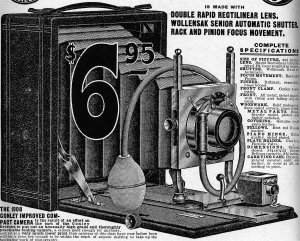
Format: 4x5
Medium: dry plate
Lens type: sliding focus
Shutter: Wollensak Senior
Aperture: f.8 - f.256
Speeds: I/B/T. About 1/50"
Same camera as the Model VI, but only available in 4x5.
Nickel plated lensboard frame featuring rise and fall movements; rack and pinion focus.
Can be tricky to distinguish from the Model XI. Look for the Wollensak Senior lens, handle that clamps to the top and not the sides, and walrus-grain leather covering.

The smallest Junior, the No.2 shown with the largest Junior, the No.3A
Format: 2 1/4 x 3 1/4 (120); 2 1/4 x 4 1/4 (No 2a); 3 1/4 x 4 1/4 (No 3); 3 1/4 x 5 1/2 (No 3a)
Medium: Roll-film (120, 116, 122, 125)
Lens type: sliding focus
Shutters: Wollensak Gammax No.2, Victo
Aperture:
Speeds: T,B, 1/100, 1/50, 1/25, 1/10
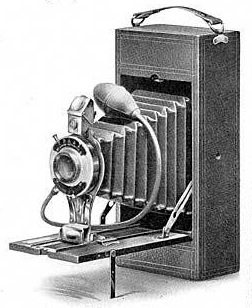 To the best of my knowledge, this is the earliest Conley roll-film camera, debuting in a Sears camera catalog in 1913, two years before the appearance of the Kewpie box camera. It was initially available in only postcard size (3 1/4 x 5 1/2), but other formats were soon introduced. Sears resisted marketing roll-film cameras for many years, unwilling to do business with members of the camera "trust", the only sources for most roll films.
To the best of my knowledge, this is the earliest Conley roll-film camera, debuting in a Sears camera catalog in 1913, two years before the appearance of the Kewpie box camera. It was initially available in only postcard size (3 1/4 x 5 1/2), but other formats were soon introduced. Sears resisted marketing roll-film cameras for many years, unwilling to do business with members of the camera "trust", the only sources for most roll films.
At left is shown an early Junior. Note the similarity to the Folding Kewpie. Because the Folding Kewpie was introduced after the Junior design change, my personal suspicion is that the aim of the first Folding Kewpies was to use up leftover pre-redesign Junior parts in a cheaper camera.
The No.2 differs from all other Juniors in that it has three focal stops like the folding Kewpie instead of the sliding focus and depth-of-field scale featured on larger Juniors. The only real difference between the No.2 Junior and the folding Kewpie is the ability to select variable shutter speeds.
(See Fixed Focus)
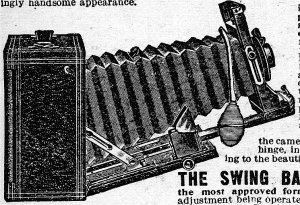
Format: 4x5, 5x7, 6 1/2 x 8 1/2, 8x10
Medium: dry plate
Lens type: sliding focus
Shutter: Conley Safety
Aperture: f.8 - f.128
Speeds: T, B, 1/100, 1/50, 1/25, 1/5, 1/2, 1"
Same camera as the Model XV.
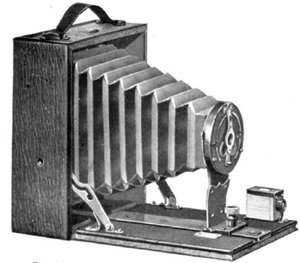
Format: 4x5
Medium: dry plate
Lens type: sliding focus
Shutter:
Aperture: 3 Waterhouse stops
Speeds: T/I
Same camera as the Shamrock.
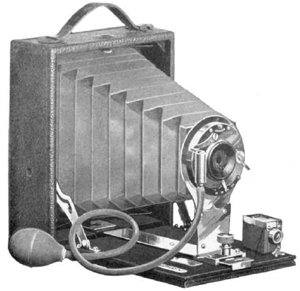
Format: 3 /14 x 4 1/4, 4x5
Medium: dry plate
Lens type: sliding focus
Shutter: Wollensak Junior
Aperture: f.8 - f.128
Speeds: T/B/I. About 1/50"
Same camera as the Pocket Folding.
Model VI
(see Improved Compact)
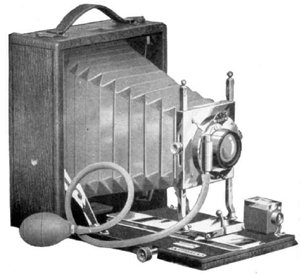
Format: 3 1/4 x 5 1/2, 4x5
Medium: dry plate
Lens type: sliding focus
Shutter: Wollensak Senior
Aperture: f.8 - f.256
Speeds: I/B/T. About 1/50"
Same camera as the Improved Compact, but also available in postcard size.
Can be tricky to distinguish from the Model XI. Look for the Wollensak Senior lens, handle that clamps to the top and not the sides, and walrus-grain leather covering.
Model VII
(see Senior Folding)
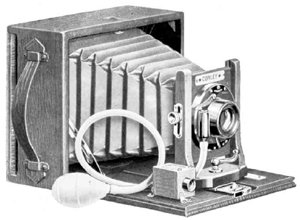
Format: 4x5, 5x7
Medium: dry plate
Lens type: sliding focus
Shutter: Wollensak Junior
Aperture: f.8 - f.128
Speeds: T/B/I. About 1/50"
Same camera as the Senior Folding.
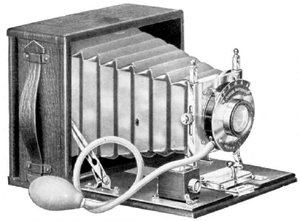
Format: 4x5, 5x7
Medium: dry plate
Lens type: sliding focus
Shutter: Conley Junior Automatic
Aperture: f.8 - f.128
Speeds: T, B, 1/100, 1/50, 1/25
Same camera as the Conley A except for the shutter..
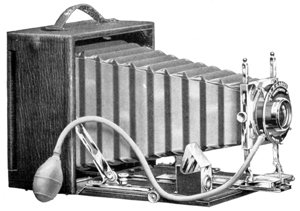
Format: 4x5, 5x7
Medium: dry plate
Lens type: sliding focus
Shutter: Conley Safety
Aperture: f.8 - f.128
Speeds: T, B, 1/100, 1/50, 1/25, 1/5, 1/2, 1"
Same camera as the Conley C.
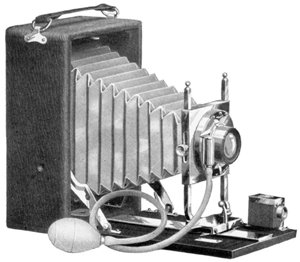
Format: 3 /14 x 5 1/2
Medium: dry plate
Lens type: sliding focus
Shutter: Wollensak Junior
Aperture: f.8 - f.128
Speeds: T/B/I. About 1/50"
Nickel-plated lensboard frame featuring rise and fall movement. Non-reversable back. When closed, can only be distinguished from the Model XI by its seal-grain keratol covering.
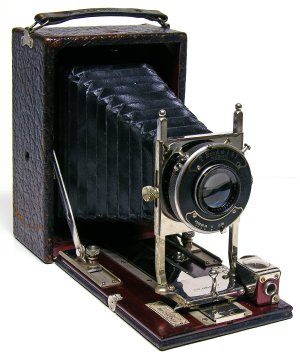
Format: 3 /14 x 5 1/2
Medium: dry plate
Lens type: sliding focus
Shutter: Conley Safety
Aperture: f.8 - f.128
Speeds: T, B, 1/100, 1/50, 1/25, 1/5, 1/2, 1"
Similar to Model X, but with slightly longer bellows (9 3/4" vs 8 1/2"), rack and pinion focus, rear tilt, and better shutter. Can be tricky to distinguish from the Model VI / Improved Compact. Look for the Conley Safety shutter, handle that clamps to the sides rather than the top, and bear-grain leather covering.
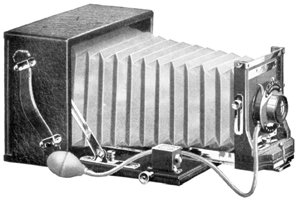
Format: 4 1/4 x 6 1/2
Medium: dry plate
Lens type: sliding focus
Shutter: Conley Safety
Aperture: f.8 - f.128
Speeds: T, B, 1/100, 1/50, 1/25, 1/5, 1/2, 1"
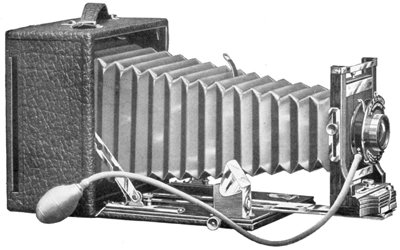
Format: 4x5, 3 1/4 x 5 1/4, 4 1/4 x 6 1/2, 5x7, 6 1/2 x 8 1/2
Medium: dry plate
Lens type: sliding focus
Shutter: Conley Safety
Aperture: f.8 - f.128 (when using convertible lenses, up to f.256)
Speeds: T, B, 1/100, 1/50, 1/25, 1/5, 1/2, 1"
Same camera as the Long Focus but with rotating reversable back and diagonally-mounted handle..
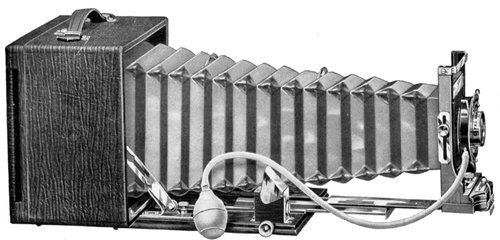
Format: 4x5, 5x7, 6 1/2 x 8 1/2
Medium: dry plate
Lens type: sliding focus
Shutter: Conley Automatic
Aperture: f.8 - f.128 (when using convertible lenses, up to f.256)
Speeds: O, T, B, 1/100, 1/50, 1/25, 1/5, 1/2, 1"
Same camera as the Double Extension, but features a rotating reversable back..
(see De Luxe)
(see De Luxe)
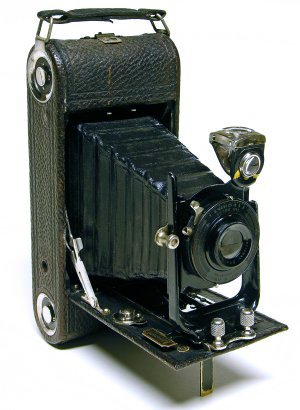
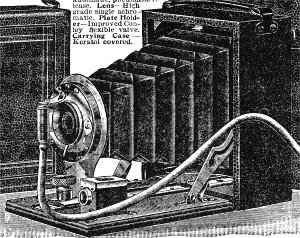
Format: 3 1/4 x 4 1/4, 4x5
Medium: dry plate
Lens type: sliding focus
Shutter: Wollensak Junior
Aperture: f.8 - f.128
Speeds: T/B/I. About 1/50"
Same camera as the Model V.
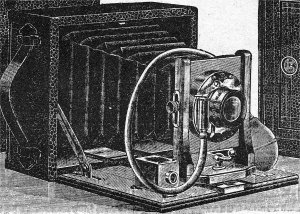
Format: 4x5, 5x7
Medium: dry plate
Lens type: sliding focus
Shutter: Wollensak Junior
Aperture: f.8 - f.128
Speeds: T/B/I. About 1/50"
Same camera as the Model VII.
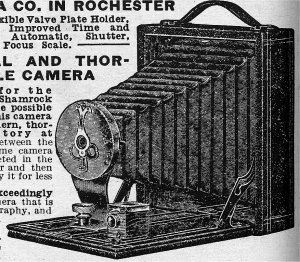
Format: 4x5
Medium: dry plate
Lens type: sliding focus
Shutter:
Aperture: 3 Waterhouse stops
Speeds: T/I
Same camera as the Model IV.